Content and Issues at each stage of a Future Marketing Communications Plan for Cafe Division
| ✓ Paper Type: Free Assignment | ✓ Study Level: University / Undergraduate |
| ✓ Wordcount: 2841 words | ✓ Published: 12 Aug 2019 |

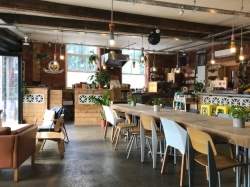
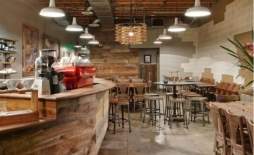
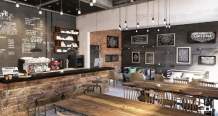

Executive Summary
This report includes the business proposal for a SME café opening in Sheffield in June 2019, Café Division. I have conducted a marketing communications plan including; a SWOT analysis, objectives, promotional vehicles and a campaign schedule. Following this is ways to evaluate and control the plan and some recommendations for the future.
Contents
1.1 Marketing Communications Audit and SWOT
1.2 Communication Objectives and Targets
Table of Figures
Introduction
Café Division’ is a new, exciting Café opening on Division Street in Sheffield City Centre, in June 2019. The unique selling point of this café is the element of a quirky interior with a modern yet vintage twist. Specialising in fresh and quirky food and drink, it will appeal to the many students in the city due to the two Universities, shoppers in the area such as West Street, The Moor and Fargate and tourists. In the future, when the business has become more established and we have built more customer loyalty and brand perception, we hope to run evening events where customers can eat and drink with a source of entertainment in the café to create an exciting evening atmosphere. The business will operate as a sole proprietorship and for the opening will require one more managerial position to work alongside the owner, 2 supervisor positions, 3 kitchen staff and 6 front of house staff.
Findings
1.1 Marketing Communications Audit and SWOT
To ensure that all the strengths and weaknesses of our new business are identified, we have carried out a SWOT and PESTLE analysis to determine these. A SWOT analysis includes internal (micro) and external (macro) environmental factors (Pickton & Broderick, 2004).
SWOT analysis
| Strengths |
|
| Weaknesses |
|
| Opportunities |
|
| Threats |
|
Figure 1
The UK coffee shops market is estimated to grow by 7.3% in 2018, to reach a value of £3.75 billion (Mintel, 2018) (see appendix 1) and is forecasted to grow by 40% in value over the next five years to reach £5.2 billion by 2023 (see appendix 2). This is evidence that the market will be financially beneficial to enter. With a population of 575,400, a high amount being in the 20 to 24 age group. This is caused by Sheffield’s significant student population at its two universities (Council, 2018). There’re an estimated 125 coffee shops/ cafes in Sheffield (Yell, 2018), these include independent cafes and market leaders such as Starbucks, Costa and Café Nero meaning there is very high competition for Café Division.
1.2 Communication Objectives and Targets
Communication objectives are an integral part of the planning process and helping with the evaluation of marketing communications activities (Fill, Marketing Communications: Interactivity, Communities and Content, 2009). These objectives should be SMART objectives (specific, measurable, achievable, realistic and timed) because of the benefits this creates.; ensuring the plan has clear and precise goals to construct a strategy (Pickton and Broderick, 2004).
The first SMART objective that Café Divison should have is brand awareness.
| Specific | Increase brand awareness by 45% four weeks before the opening day through the use of the promotional vehicles. |
| Measurable | This can be measured through tracking website traffic and social media presence before and after the promotional vehicles and marketing communications. |
| Achievable | This is an achievable objective as after the evaluation of the market environment and business, the Café will be appealing to many people. |
| Realistic | To achieve this, the promotional vehicles for the Café need to be carried out effectively by those working for the Café. The target customers can be reached through marketing communications, especially social media. |
| Timely | Measured between the start of promotion and the four weeks before the opening. |
Figure 2
Brand awareness is vital to getting an enterprise started as this as how a business gains customers, potentially brand loyalty and profits; overall building a successful enterprise (Yeshin, 2006).
Another important objective is to have a certain number of customers within the first 6 months of opening.
| Specific | To have at least 5,000 customers within the first 6 months of opening. |
| Measurable | This can be measured through the amount of sales that the Café makes in those 6 months. |
| Achievable | This is an achievable objective as there are 575,400 people in Sheffield, meaning there is a high number of potential customers. |
| Realistic | To achieve this, the promotional vehicles need to continue to be effective to keep customers returning and to attract new customers. Also, the instore experience needs to be positive to impress the customers. |
| Timely | Measured between the opening of the café and 6 months after this. |
Figure 3
Additionally, when looking at our targets we looked at the ATR model by Ehrenberg in 1974 (awareness, trial, reinforcement) (Paul Russell Smith, 2004). This model helps us to set a target for each element. As stated in the SMART objective for brand awareness, we are aiming to increase awareness by 45%. On the opening day we are aiming to have at least 150 customers, linking to the trial element of this model. Finally, we will reinforce our advertisement and the customer experience.
1.3 Promotional Videos
The communications plan needs to ensure that the most appropriate promotional vehicles are used to create an effective marketing communication. These include; sales, advertising, public relations and social and digital.
1.4 Sales Promotion
Sales promotion is the process of persuading customers to buy your product (Fill, 2013). We can use this a short term way to initally boost sales of Café Division. Instore selling promotions would be effective on the first day of opening, with a 10% discount for the first 50 customers. Additionally, on the opening day vouchers for the customers will be handed out for 10% off all food and drink. In the future, we would look into having a type of loyalty cards where after 6 visits customers can get a free drink of their choice. This would help to compete against the competitor café’s in the city.
1.5 Advertising
Fill (2009) states that advertising is important in the role of a marketing communications plan as it has the potential to engage audiences with the main function of advertising being to communicate with your audience – the prim objective being to maintain awareness of a product or organisation. However, advertising does have it drawbacks which include the fact that it is sometimes controversial, expensive and isn’t directly personal to a customer group.
With there being many ways to advertise, we need to think of the most effective ways to reach and appeal to our target audience. With Sheffield having just over 60,000 students in the city, a large segment of the primary target audience will be 18-24-year olds, who use social media as a way of consuming advertising and media. This means that social media will be the most effective way of reaching this target group. In January 2018, 44 million people were found to be active social media users, with 38 million of these being active mobile social media users (Statista, 2018). This will be a low cost, easy way to advertise Cafe Division, with most of these customers being able to consume the advertisement straight from their mobile phone.
Alongside social media, we will launch a website which we will be advertised across social media platforms. The website will include information about the Café, the menu, offers and events.
1.6 Public Relations
The purpose of public relations (PR) is to create a positive image of a company/organisation in the mind of its consumers (Blythe, 2006), bringing attention to the public to the company through an event or news story. It can be argued that PR isn’t a form of marketing as it isn’t measured in financial terms, however, it does bring attention to a new company. In a press release, a beneficial amount of information can be included to grab a reader’s attention (Blythe, 2006). Therefore, we feel it would be to our advantage to conduct a press release as this will allow possible customers to become aware of our brand and will be more likely to visit if they are more informed about this new enterprise. An effective platform to release a press release through would be the Sheffield Star, a daily newspaper distributed in South Yorkshire and parts of the East Midlands, with a readership of 13,658 (Kerridge, 2018). Additionally, the Sheffield Star twitter page has 165,000 followers (Twitter, 2018) and alongside the website will engage with many of our target customers. This will create brand awareness and an excitement around the opening.
1.7 Social and Digital
The social and digital platforms will link back to the advertising element of the promotional vehicles. This is because the majority of our target audience consume digital platforms every-day, making this a beneficial way of promoting Café Division. Advertising Association (2018) states that mobile continues to grow in the advertising world with over 90% of additional mobile investment directed towards search and social media in 2017. This means that more people are using social media and digital platforms to consume media and advertising. This is evidenced in this image below (see appendix 4. With this knowledge on social and digital media, we are looking into creating a hashtag to be a part of our advertising campaign. This would be something simple such as #cafedivisonsheff. This includes our name and the location, allowing people online to use the hashtag to either promote or find out information
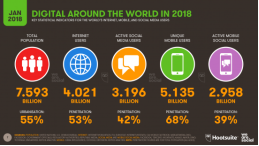
Figure 4
1.8 Campaign Schedule
As we are a new enterprise, we have prepared a campaign schedule formed from the promotional vehicles we have decided on for Café Division.
| May | June | December | |
| Public Relations | | ||
| Advertising | | ||
| Social Media | | ||
| Sales Promotions | | |
Figure 5
Public Relations:
The campaign schedule will start on May 4th, with the press release in The Sheffield Star to begin building brand awareness with potential customers.
Advertising:
The second stage of the campaign schedule will be the beginning of advertising; primarily across social media and the website. This will start on May 11th.
Secondly, we will distribute printed flyers in Sheffield City Centre, near both Universities and near the train station. This will allow us to get people interested and reinforce or brand.
After the opening, dependent on success, we will look into paying for social media advertisement in Facebook and Twitter.
Social Media:
The third stage of our schedule includes a focus on social media and using it to deliver information as well advertising the Café. This will begin around the same time as the advertising as a way of providing more detail about our Café.
Sales Promotions:
The final stage of the initial campaign schedule will be the sales promotions which we will begin goffering on the opening day through our 10% off vouchers which will be valid for 6 months.
If successful we will then launch our loyalty cards to build brand loyalty.
This campaign schedule takes elements of the DRIP model; differentiate, reinforce, inform and persuade (see appendix 3). It is not necessarily carried out in this exact order however each element of this model is supported though the campaign schedule (Fill, 2009). Café Division is differentiated through our advertising, reinforced through social media, informed through PR and persuaded through sales promotions.
2.0 Evaluation and Control
To evaluate the success of this marketing communications plan, we will be referring back to our SMART objectives to ensure we are on track throughout the opening of the café and the following year. These SMART objectives alongside the ATR model should help us to stay focused on our goals. We will make sure that we have weekly meetings in the beginning to check these targets and make any necessary changes.
Additionally, we are conducting a gap analysis, which involves the comparison of our actual performance with what our potential or desired performance could be. This will allow us to reflect on our strengths and weaknesses as a business (Business Directory, 2018) based on the commications plan; SWOT, objectives, promotional vehicles and the campaign schedule. The following gap analysis chart shows the potential current performance (A) and the desired outcome (B) (see appendix 4).

Figure 6
Recommendations
Finally, we think we should look at expansion in the future into other cities, firstly in Yorkshire and then the East Midlands such as Leeds, York, Derby and Nottingham. This is dependent on the success of the café in Sheffield. After we become more established in Sheffield, we would look at reducing advertising spending as there will be other elements we will need to venture into, such as branding our cups and possibly starting a takeaway service to compete with the big-name brands such as Costa and Starbucks.
Appendices
- Mintel. (2018, December). Coffee Shops – UK – December 2018. Retrieved from Mintel Academic: http://academic.mintel.com/display/859807/
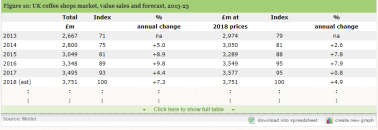
- Mintel. (2018, December). Coffee Shops – UK – December 2018. Retrieved from Mintel Academic: http://academic.mintel.com/display/859807/
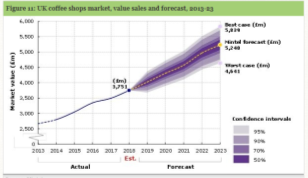
- https://www.smartinsights.com/traffic-building-strategy/offer-and-message-development/use-drip-model/
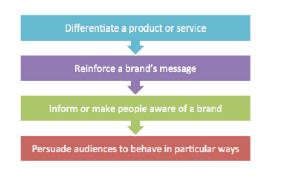
 4)
4)
This Gap analysis chart is a simplified example of what the current and desired outcome could be for Café Division. Outcome A is an example of what the outcome from the initial opening could be and B is an example of what we could aspire to achieve for the desired outcome.
Bibliography
Association, A. (2018). 2017 definitive advertising statistics. Retrieved from Advertising Association: https://www.adassoc.org.uk/2018/04/2017s-definitive-advertising-statistics-released-today/
Blythe, J. (2006). Essentials of Marketing Communications. England: Pearson Education Limited.
Broderick, D. P. (2004). Integrated Marketing Communications. Pearson Education.
Council, S. C. (2018, October). Sheffield’s Population . Retrieved from Sheffield City Council: https://www.sheffield.gov.uk/home/your-city-council/population-in-sheffield.html
Directory, B. (2018). Gap analysis. Retrieved from Business Directory: http://www.businessdictionary.com/definition/gap-analysis.html
Fill, C. (2009). Marketing Communications: Interactivity, Communities and Content. London: Prentice Hall.
Fill, C. (2013). Marketing Communications brands, experiences and participation . Pearson.
Kerridge, D. (2018, August). Sheffield Star readership. Retrieved from abc.org.uk: https://www.abc.org.uk/product/9809
McDonald, M. (1999). Marketing Plans: How to Prepare Them, how to Use Them. Butterworth-Heinemann.
Mintel. (2018, December). Coffee Shops – UK – December 2018. Retrieved from Mintel Academic: http://academic.mintel.com/display/859807/
Paul Russell Smith, J. T. (2004). Marketing Communications: An Integrated Approach. Kogan Page Publishers.
Statista. (2018, January). Total number and the share of population of active social media and mobile social media users in the United Kingdom (UK) in January 2018. Retrieved from Statista: https://www.statista.com/statistics/507405/uk-active-social-media-and-mobile-social-media-users/
Twitter. (2018, December). The Star, Sheffield. Retrieved from Twitter: https://twitter.com/SheffieldStar?ref_src=twsrc%5Egoogle%7Ctwcamp%5Eserp%7Ctwgr%5Eauthor
Yell. (2018). Sheffield Coffe Shops and Cafes. Retrieved from Yell.com: https://www.yell.com/ucs/UcsSearchAction.do?scrambleSeed=1037776465&keywords=cafes&location=sheffield&pageNum=5
Yeshin, T. (2006). Advertising. London: Thomson Learning.
References
Association, A. (2018). 2017 definitive advertising statistics. Retrieved from Advertising Association: https://www.adassoc.org.uk/2018/04/2017s-definitive-advertising-statistics-released-today/
Blythe, J. (2006). Essentials of Marketing Communications. England: Pearson Education Limited.
Broderick, D. P. (2004). Integrated Marketing Communications. Pearson Education.
Council, S. C. (2018, October). Sheffield’s Population . Retrieved from Sheffield City Council: https://www.sheffield.gov.uk/home/your-city-council/population-in-sheffield.html
Directory, B. (2018). Gap analysis. Retrieved from Business Directory: http://www.businessdictionary.com/definition/gap-analysis.html
Fill, C. (2009). Marketing Communications: Interactivity, Communities and Content. London: Prentice Hall.
Fill, C. (2013). Marketing Communications brands, experiences and participation . Pearson.
Kerridge, D. (2018, August). Sheffield Star readership. Retrieved from abc.org.uk: https://www.abc.org.uk/product/9809
Mintel. (2018, December). Coffee Shops – UK – December 2018. Retrieved from Mintel Academic: http://academic.mintel.com/display/859807/
Paul Russell Smith, J. T. (2004). Marketing Communications: An Integrated Approach. Kogan Page Publishers.
Statista. (2018, January). Total number and the share of population of active social media and mobile social media users in the United Kingdom (UK) in January 2018. Retrieved from Statista: https://www.statista.com/statistics/507405/uk-active-social-media-and-mobile-social-media-users/
Twitter. (2018, December). The Star, Sheffield. Retrieved from Twitter: https://twitter.com/SheffieldStar?ref_src=twsrc%5Egoogle%7Ctwcamp%5Eserp%7Ctwgr%5Eauthor
Yell. (2018). Sheffield Coffe Shops and Cafes. Retrieved from Yell.com: https://www.yell.com/ucs/UcsSearchAction.do?scrambleSeed=1037776465&keywords=cafes&location=sheffield&pageNum=5
Yeshin, T. (2006). Advertising. London: Thomson Learning.
Cite This Work
To export a reference to this article please select a referencing stye below:
Related Services
View allDMCA / Removal Request
If you are the original writer of this assignment and no longer wish to have your work published on UKEssays.com then please click the following link to email our support team:
Request essay removal



